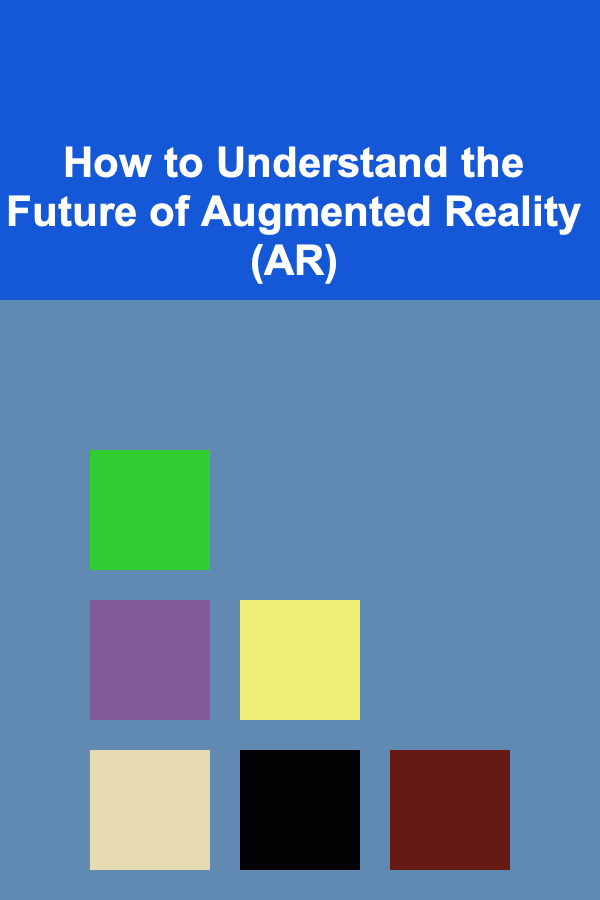
How to Understand the Future of Augmented Reality (AR)
ebook include PDF & Audio bundle (Micro Guide)
$12.99$8.99
Limited Time Offer! Order within the next:

Augmented Reality (AR) has captured the imagination of technologists, creators, and everyday users alike. It has transformed the way we interact with the digital world, blending physical and virtual experiences in ways that seemed like science fiction only a few decades ago. With the rapid evolution of hardware, software, and development tools, AR is poised to revolutionize numerous industries from gaming and education to healthcare and business. But how can we understand the future of AR? What trends, innovations, and challenges will shape its trajectory? In this article, we will explore the current landscape of AR, the key factors influencing its future, and the potential societal impacts of this transformative technology.
The Current State of Augmented Reality
Before delving into the future, it's important to first understand where AR stands today. Augmented Reality refers to the integration of digital content into the real world, typically through devices like smartphones, tablets, smart glasses, and headsets. Unlike Virtual Reality (VR), which immerses users in entirely digital environments, AR enhances the user's perception of the real world by superimposing digital information on it.
1.1. AR in Consumer Technology
In the consumer sector, AR is already making waves. The most common example is AR-enabled mobile apps that use the phone's camera and sensors to overlay digital objects onto the physical world. A prime example is Pokémon GO, a mobile game that became a cultural phenomenon by combining AR with gaming. Other apps, such as IKEA Place, allow users to visualize furniture in their homes through AR, providing a more intuitive and interactive shopping experience.
Moreover, social media platforms have embraced AR, allowing users to apply filters to their photos and videos in real time. Instagram and Snapchat, for instance, popularized AR filters, from dog ears to augmented makeup. These filters create a playful and engaging way for users to interact with their content, and the widespread use of AR in social media is helping normalize the technology for a larger audience.
1.2. AR in Enterprise Solutions
Beyond consumer applications, AR is gaining traction in enterprise environments. Businesses in industries like manufacturing, logistics, healthcare, and education are increasingly adopting AR solutions to improve productivity, training, and customer experience. For example, in healthcare, AR is being used for surgery preparation and medical education by overlaying patient data on a real-time view of a patient's body.
In manufacturing, AR can assist technicians by displaying real-time data, maintenance instructions, or step-by-step guidance directly on equipment, reducing errors and downtime. Similarly, in logistics, AR glasses are helping warehouse workers by displaying the most efficient routes and stock information, significantly improving inventory management and order fulfillment.
While the consumer market has been a major driver of AR innovation, the enterprise sector is expected to be an even more significant catalyst for AR's widespread adoption in the coming years.
Key Drivers of AR's Future
To understand where AR is headed, we need to consider the key drivers of its evolution. These include technological advancements, changing user behavior, and shifts in societal needs and preferences.
2.1. Advancements in Hardware
The future of AR is closely tied to the development of new hardware. Currently, most AR applications rely on smartphones or tablets, which offer limited user experiences due to the size and form factor of these devices. For AR to reach its full potential, it requires dedicated hardware like smart glasses or headsets that are comfortable, lightweight, and capable of delivering seamless experiences.
The next generation of AR headsets, such as Microsoft's HoloLens 2, Magic Leap 2, and Apple's rumored AR glasses, are expected to bring significant improvements in processing power, field of view, and user interaction. These devices will feature more advanced sensors, better graphics, and improved battery life, which will allow for more immersive and practical AR experiences. As hardware continues to evolve, we can expect more compact, user-friendly, and versatile AR devices that integrate more naturally into daily life.
2.2. Improvements in Software and AI
The software powering AR is also evolving rapidly. AR platforms, such as ARKit (for iOS) and ARCore (for Android), have made it easier for developers to create AR experiences by offering robust frameworks for motion tracking, scene understanding, and environmental detection. As these platforms improve and new ones emerge, the scope of AR applications will expand, allowing for more dynamic and interactive experiences.
Artificial Intelligence (AI) will also play a key role in AR's future. AI can enable AR systems to better understand the environment, recognize objects, and anticipate user actions. For example, AI-powered AR systems could recognize a user's intent and adjust the digital content accordingly, making interactions feel more intuitive and seamless. Moreover, machine learning algorithms could improve object recognition and tracking, leading to more accurate and realistic AR experiences.
2.3. 5G Connectivity
Another crucial factor influencing the future of AR is the advent of 5G networks. With its ultra-low latency, high bandwidth, and faster speeds, 5G will enable AR experiences that are more responsive and fluid. Currently, AR applications can be limited by the processing power of local devices, which means that complex AR content must be processed on the device itself. With 5G, AR applications could offload some of the processing to the cloud, reducing the reliance on the device's hardware and enabling richer, more complex AR experiences.
In addition, 5G's improved connectivity will help ensure that AR applications are more stable and can deliver real-time, high-quality interactions even in crowded or high-traffic environments.
2.4. Miniaturization of Devices
As AR technology continues to evolve, miniaturization will be a major factor in making AR more accessible. Today, many AR systems require bulky headsets or glasses that are not practical for everyday use. However, future developments will focus on creating smaller, more compact devices that are comfortable to wear for extended periods without sacrificing performance. For example, companies like Apple are working on developing lightweight, stylish AR glasses that users can wear just like regular eyewear, seamlessly integrating into their daily lives.
This miniaturization will lead to more widespread adoption of AR, as the technology becomes less intrusive and easier to use in various contexts.
Applications of AR in the Future
As the hardware and software continue to improve, the potential applications of AR will expand dramatically. Here are some of the key areas where AR is expected to have a significant impact in the future:
3.1. Education and Training
One of the most promising areas for AR is education and training. With AR, students can engage with interactive learning experiences that bring abstract concepts to life. For example, AR could be used to visualize complex scientific processes, such as the structure of molecules or the dynamics of the human circulatory system, making learning more engaging and accessible.
In the workplace, AR could revolutionize training programs. Employees could undergo hands-on training without the need for physical resources or instructors, simply by using AR to simulate real-world scenarios. This could be particularly beneficial for industries like manufacturing, healthcare, and emergency services, where training can be costly or dangerous.
3.2. Healthcare
In healthcare, AR has the potential to improve everything from diagnostics to patient care. Surgeons could use AR to overlay vital patient data during procedures, enhancing precision and reducing errors. Medical students could use AR for immersive simulations, learning anatomy and practicing surgical techniques without needing cadavers or expensive equipment.
AR could also improve patient experiences. For instance, patients could use AR to better understand their conditions and treatment options, visualizing the impact of certain procedures in real time. Similarly, AR could assist in physical rehabilitation by providing visual feedback and guidance for patients as they perform exercises.
3.3. Retail and E-commerce
In retail, AR is already transforming the shopping experience, and the future promises even more innovation. Imagine being able to try on clothes virtually or place furniture in your living room before making a purchase. AR could allow for highly personalized shopping experiences, tailoring product recommendations and visualizations based on the individual's preferences and context.
Additionally, AR could help retailers create more engaging in-store experiences. For example, AR could provide customers with interactive product information or allow them to navigate stores more efficiently with digital signage and location-based guides.
3.4. Social Interaction and Communication
As AR devices become more accessible, social interaction is likely to undergo a transformation. AR could enable new forms of communication by allowing users to overlay digital content into real-world environments, enhancing face-to-face interactions. For example, video calls could take on a new dimension by allowing participants to interact with digital avatars or objects during conversations.
In social media, AR could evolve into more immersive forms of self-expression. Users may share not only photos and videos but also interactive AR experiences, where friends can participate in a shared virtual world.
3.5. Entertainment and Gaming
Gaming is perhaps one of the most obvious areas where AR will continue to thrive. With the success of games like Pokémon GO, we've seen that blending virtual elements with the real world can create exciting, immersive experiences. As AR hardware improves, we can expect more advanced games that merge the physical and virtual worlds in innovative ways.
Beyond gaming, AR could be used in entertainment for interactive live events, concerts, and performances, where audiences experience augmented visuals that enhance the event. Movies and television shows may also incorporate AR to create new forms of storytelling that invite viewers to engage with the narrative in novel ways.
Challenges and Considerations
While the future of AR is filled with promise, there are several challenges that need to be addressed for it to reach its full potential.
4.1. Privacy and Security
As AR devices become more integrated into daily life, privacy and security concerns will become more prominent. AR systems rely heavily on sensors and cameras, which could potentially capture sensitive personal data. This raises questions about data privacy, surveillance, and the ethical use of AR technologies.
Ensuring that AR platforms adhere to stringent privacy standards and are transparent about how they collect and use data will be critical to gaining user trust.
4.2. Accessibility and Inclusivity
For AR to have a truly transformative impact, it must be accessible to all users, including those with disabilities. Designers must ensure that AR applications are inclusive, offering features like voice commands, customizable interfaces, and compatibility with assistive technologies.
Additionally, as AR becomes more prevalent, it will be important to consider the economic barriers to access. While the costs of devices may decrease over time, ensuring that AR is affordable and accessible to diverse populations will be crucial for equitable adoption.
4.3. Social and Psychological Impacts
As AR becomes more embedded in our daily lives, we will need to consider its social and psychological effects. Will AR contribute to greater social isolation, or will it foster more meaningful connections? How will the blurring of physical and digital realities affect our perception of the world?
There is also the potential for AR to create information overload. With constant digital overlays, users may become overwhelmed by the sheer volume of data and stimuli. Balancing the benefits of enhanced experiences with the potential for distraction will be a key consideration.
Conclusion
The future of Augmented Reality is incredibly promising, with the potential to revolutionize nearly every aspect of our lives. As technological advancements continue to improve hardware, software, and connectivity, the possibilities for AR applications will expand dramatically. However, for AR to truly reach its potential, we must address the challenges of privacy, accessibility, and social impact. The future of AR will be shaped by how we navigate these challenges while harnessing the technology's incredible power to enrich and transform our world.

How to Maximize Natural Light in Your Home Renovation
Read More
How to Simplify Your Budget by Cutting Down on Subscription-Based Online Services
Read More
How To Start Skydiving Safely
Read More
How to Store Vintage Linens Without Damage
Read More
How to Invest in Climate-Friendly Transportation
Read More
How To Discover the Story of Persephone
Read MoreOther Products

How to Maximize Natural Light in Your Home Renovation
Read More
How to Simplify Your Budget by Cutting Down on Subscription-Based Online Services
Read More
How To Start Skydiving Safely
Read More
How to Store Vintage Linens Without Damage
Read More
How to Invest in Climate-Friendly Transportation
Read More